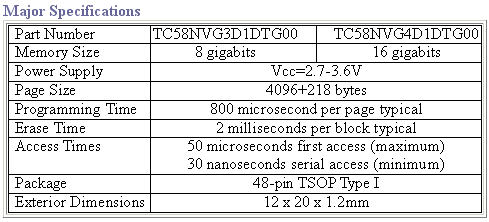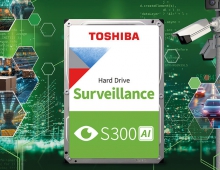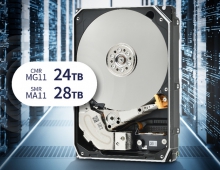
Toshiba to Launch 56-Nanometer, 16-Gigabit NAND Flash Memory
Japan's Toshiba said on Wednesday it will match rival Samsung 's March launch of the industry's first 2-Gigabyte NAND flash chip by mass-producing a chip with as much storage a month later.
Toshiba, the world's second-largest NAND chip maker after Samsung, is eyeing an expected a surge in demand propelled by Apple's music-playing iPhone, analysts said.
The iPhone -- which will come with 4 or 8 gigabytes of NAND -- has fueled hope among flash memory makers, weary of price falls eating away at profit margins, said Mizuho Investors Securities analyst Yuichi Ishida.
Toshiba, which aims to take a combined 40 percent market share with partner SanDisk by 2008, will begin by shipping samples of its 2-Gigabyte chips in March, using 56-nanometre process technology, and plans monthly shipments of 300,000 chips from April.
Cutting edge 50- and 56-nanometre microchips have smaller gaps between transistors than 60- or 70-nanometre ones, meaning more power can be packed into less space for lower per chip costs.
Toshiba also expects to begin mass production of 1-Gigabyte NAND chips using 70-nanometre processes by the end of January.
Memory makers have been boosting plant spending in quest of ever smaller circuitry, despite price falls of some 70 percent in 2006.

The iPhone -- which will come with 4 or 8 gigabytes of NAND -- has fueled hope among flash memory makers, weary of price falls eating away at profit margins, said Mizuho Investors Securities analyst Yuichi Ishida.
Toshiba, which aims to take a combined 40 percent market share with partner SanDisk by 2008, will begin by shipping samples of its 2-Gigabyte chips in March, using 56-nanometre process technology, and plans monthly shipments of 300,000 chips from April.
Cutting edge 50- and 56-nanometre microchips have smaller gaps between transistors than 60- or 70-nanometre ones, meaning more power can be packed into less space for lower per chip costs.
Toshiba also expects to begin mass production of 1-Gigabyte NAND chips using 70-nanometre processes by the end of January.
Memory makers have been boosting plant spending in quest of ever smaller circuitry, despite price falls of some 70 percent in 2006.






















